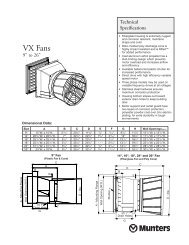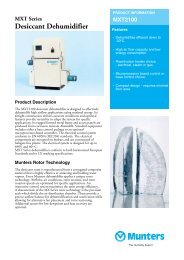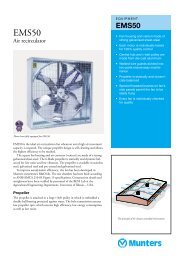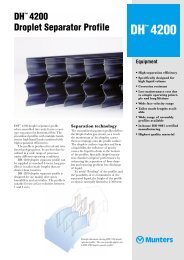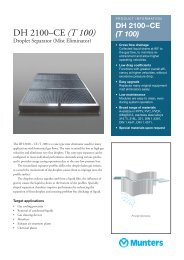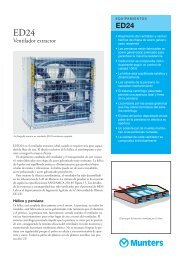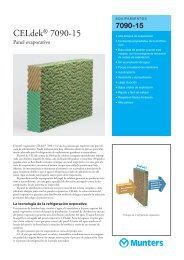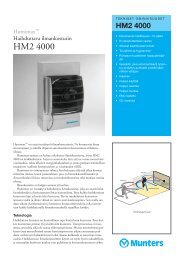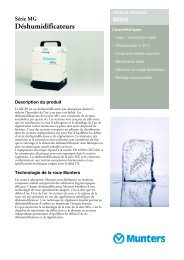Annual Report 2006 - Munters
Annual Report 2006 - Munters
Annual Report 2006 - Munters
You also want an ePaper? Increase the reach of your titles
YUMPU automatically turns print PDFs into web optimized ePapers that Google loves.
Borrowing costsBorrowing costs are reported as costs in the period in which they arise,regardless of how the borrowed funds are employed.Government grantsGovernment grants are reported at fair value when it may be presumed withreasonable certainty that a grant will be received and that the Group will fulfill allthe conditions attached thereto.Government grants related to the acquisition of assets are reported in thebalance sheet through the reduction by the grant of the reported value of theasset. Government grants attributable to costs are reported as deferred incomeand reported as revenue as the costs that the grant is designed to offset arise.When a government grant is attributable neither to the acquisition of assets norto remuneration of costs, it is reported as other income.Transactions in foreign currencyTransactions in foreign currency are translated at the exchange rate on thetransaction date. Monetary assets and liabilities in foreign currencies aretranslated at the year-end rate and any resulting translation differences arebooked to earnings. Accordingly, both realized and unrealized exchange-ratedifferences are reported in the income statement. Exchange-rate differencesconcerning operating receivables and liabilities are reported under operatingearnings, while exchange rate differences attributable to financial assets andliabilities are reported as a financial expense.Financial derivativesFinancial derivatives are initially reported at acquisition cost in the balance sheet,and thereafter at the prevailing market value on subsequent closing dates. Themethod of reporting any gains or losses that arise varies depending on thecharacter of the risk-hedged interest.When a derivative contract is purchased, it is classified either as 1) a hedgeof the market value of a reported asset or liability (market-value hedging), 2) ahedge of a planned transaction or definite undertaking (cash-flow hedging), 3) ahedge of a net investment in a foreign company, or 4) a derivative that does notmeet the requirements for hedge accounting.Changes in the market value of such derivatives that are classified as, andmeet the requirements for, market-value hedging, and that can be objectivelyestablished, are reported in the income statement with any market valuechanges of the asset or liability to which the risk hedging pertains.Changes in the market value of such derivatives that are classified as, andmeet the requirements for, cash flow hedging, and that can be objectivelyestablished, are reported under equity as a hedge reserve until the day whenthe hedged interest is booked. When the hedged interest is booked, earningsarising from any related derivatives are reported in the income statement. If aplanned transaction or a commitment undertaken is no longer expected to takeplace, any related gains or losses booked to equity must be immediatelytransferred to the income statement.Certain derivative transactions do not fulfill the requirements for hedgeaccounting in accordance with IAS 39 (Financial instruments: Recognition andmeasurement), although they are economically justified in accordance with theGroup’s risk management policy. Changes in the market value of suchunqualified hedging transactions are reported immediately in the incomestatement. <strong>Munters</strong> does not hedge net investments in foreign subsidiaries.Accumulated translation differencesTranslation differences relating to investments in foreign operations must bereported as a separate item in equity in accordance with IAS 21 (Effects ofchanges in foreign exchange rates). In conjunction with the sale of foreignoperations, accumulated translation differences must be reported as part of thegain/loss from the divestment. <strong>Munters</strong> has elected to set accumulatedtranslation differences at zero as per 1 January 2004 in accordance with thetransition rules in IFRS 1.Income taxesIncome taxes in the consolidated financial statements consist of current anddeferred tax.Current taxes are based on each company’s taxable income as reported inits tax return. This includes an adjustment for current tax attributable to previousperiods.Deferred tax is calculated to correspond to the tax effect that arises whenfinal tax is triggered. It is based on temporary differences between book valuesin the balance sheet and residual values for tax purposes. The amounts arecalculated using the tax rates that were effect or had been announced on theclosing date. Temporary differences arise in conjunction with companyacquisitions as the difference between the value of assets and liabilities in theconsolidated balance sheet and their value for tax purposes. Deferred tax onloss carry-forwards is reported as an asset in cases where it is probable that itwill result in lower tax payments in the future.Deferred tax referring to temporary differences attributable to investments insubsidiaries and associated companies are not reported, since in all suchcases, the Parent Company can control the time of the reversal of thetemporary differences and it is considered unlikely that a reversal will occur inthe near future.Untaxed reserves are divided into deferred tax liability and equity.Contingent liabilitiesContingent liabilities are reported when there are possible obligations relating totranspired events that will only become actual obligations given the occurrenceor non-occurrence of one of more uncertain future events that are completelyoutside the control of <strong>Munters</strong>. Contingent liabilities may also be an obligationarising from transpired events but which is not reported as a liability or aprovision because it is not probable that the obligation will be settled or becausethe settlement amount cannot be calculated with sufficient reliability.Information concerning related partiesCompanies related to <strong>Munters</strong> includes the Parent Company, subsidiaries andassociated companies. “Related physical persons” are defined as Boardmembers, senior management and close family members of such persons.Information on transactions with related parties that entail a transfer ofresources, services or obligations between related parties is disclosed,regardless of whether remuneration was paid or not. The disclosure containsinformation as to the character of the relationship and the effect of therelationship on the financial reports.Events after the closing dayIf events arise that are significant, but that should not be taken into accountwhen the amounts in the income statement and balance sheet are established,information will be provided in the Board of Directors’ report and notes as to thecharacter of the event and if possible an estimate of its financial effect. The term“significant” implies that a disclosure of the information could influence financialdecisions made by users of the financial reports.Significant events that confirm the relationship that existed on the closingdate and that occur after the closing date but prior to the signing of the <strong>Annual</strong><strong>Report</strong> result in adjustments in the amounts in the <strong>Annual</strong> <strong>Report</strong>.Accounting principles of the Parent CompanyThe Parent Company has prepared its annual accounts in accordance with the<strong>Annual</strong> Accounts Act and recommendation RR 32:05 of the Swedish FinancialAccounting Standards Council, <strong>Report</strong>ing for legal entities, and applicablestatements from the Emerging Issues Task Force. RR 32:05 implies that theParent Company, in the annual accounts for legal entities, applies all EUapprovedIFRS/IAS and statements to the extent this is possible within theframework of the <strong>Annual</strong> Accounts Act and the law on safeguarding of pensioncommitments pertaining to the connection between the accounting andtaxation.The Parent Company primarily applies the principles pertaining to the Groupdescribed above. The differences between the Group’s and the ParentCompany’s accounting principles are stated below.PensionsThe Parent Company’s pension commitments are calculated and accountedbased on the law on safeguarding of pension commitments. Application of thelaw on safeguarding of pension commitments is a prerequisite for the right totax deductions.Financial instrumentThe Parent Company does not apply IAS 39 Financial instruments: Accountingand Valuation, instead valuations are based on the acquisition value of assetsand liabilities.Group contributions and shareholders’ contributionsThe Parent Company reports Group contributions and shareholders’ contributionsin accordance with statements from Emerging Issues Task Force.Shareholders’ contributions are reported directly against the receiver’s equityand capitalized in the shares and participations of the provider, to the extent thatimpairment is not required. Group contributions are reported according tofinancial significance. This means that Group contributions that are made tominimize the Group’s total tax are reported directly against profit broughtforward after deductions of current tax effects.M U N T E R S A N N U A L R E P O R T 2 0 0 6 51





